Need for Further Structural Mechanics Study on Radiata Pine Wood Properties
Ping Xu
Forest Research
PO Box 29 237, Fendalton
Christchurch
New Zealand
Correspondence to: [email address]
Abstract
This paper stresses the need for the study of structural mechanics in relation to radiata pine wood
properties, through a review of previous and current researches on stems, structural boards and wood
cells.
Along the vertical direction, the worst characteristic stiffness and characteristic tensile strength both
occurred in the corewood of butt log, which did not match the distribution pattern of low-density wood
in the radiata pine corewood. In addition, there was an enlarged conical low-stiffness wood zone rising
from the base to about 3 meter of the tree, which also differed from the distribution pattern of the low-
density wood. For a structural board, there was a poor relationship between the wood density, local
stiffness and tensile strength at the failure point. The knot–related structural factors, such as branch
growth angle and structural discontinuity of wood grain, significantly affected the mechanical
properties, although knot area ratio alone did not predict the mechanical properties at the failure point
in a structural board. At the micro-scale, the previous structure-stiffness models have not well agreed
with the experimental data at the small microfibril angles. Further experimental and theoretical
investigations are required to explain the influence of cell morphology on the cell mechanical
properties.
Introduction
Structural mechanics of biomaterials investigates the relationships between the structural properties
and mechanical properties in the living tissues and the resulting biomaterial products. Stiffness and
strength are key quality criteria for wood-based biomaterials including standing trees, structural boards
and individual wood cells; thus they are the major concerns of structural mechanics (Mark 1967,
Preston 1974, Bodig and Jayne 1982, Madsen 1992). Owing to heterogeneity and anisotropy of wood-
based biomaterials, stiffness and strength vary with the location of specimen and highly depend on
structural factors both at macro- and micro scales. Efforts over recent decades include the following:
corewood (the first 10 growth rings from the pith) has been identified as a problem zone in radiata pine
trees due to the poor stiffness and strength (Cown 1992, Walker 1998a, 1998b); knots have been
4th plant Biomechanics International Conference – East Lansing, USA
Page 1
considered as the major degrading factor of mechanical properties in structural timber (Kunesh &
Johnson, 1972, Tustin & Wilcox 1978, Phillips et al. 1981, Grant et al. 1984, AS 2858: 1986, Pellicane
et al. 1987, Barrett & Kellogg 1991, Madsen 1992, Walker 1993, Courchene et al. 1998, Nguedjio
1999); and high average microfibril angle has been acknowledged to be one of the key factors
responsible for poor wood stiffness (Cave & Walker 1994, Walker & Butterfield 1995, Cave 1997a,
1997b, Evans & Ilic 2001). However, the mechanism regarding the contribution of structural features
to mechanical properties is still far from fully understood. The major needs in wood structural
mechanics are discussed in this paper.
Stiffness and Tensile Strength in Radiata Pine Stems
Radiata pine corewood (the first 10 growth rings from the pith) has been well known as struggling to
yield structural timber due to the poor wood properties. However, the vertical variations of the
characteristic mechanical properties in the radiata pine corewood have not been reported previously in
detail. Recently, the lowest characteristic stiffness and characteristic tensile strength were found in the
butt corewood zone (Fig. 1). More significant is that, based on machine stress grading and tensile
testing, Xu and Walker (in press) identified an enlarged low-stiffness wood zone in the radiata pine
butt logs. This low-stiffness wood zone did not overlap with the corewood, or rather, this low-stiffness
wood formed a truncated cone from the base of the tree to approximately 3 meters up the stem (Fig. 2).
A similar observation was found in Norway spruce (Perstorper 1996), but the volume of the low-
stiffness wood cone in Norway spruce was insignificant compared to that in the radiata pine butt log.
6.5
7.8
6
7.6
7.4
Pa) 5.5
tensile (M
7.2
5
R k
7
stiffnessE k Pa)
4.5
6.8
(G
Rk
6.6
haracteristic
4
C strength
6.4
Ek
3.5
haracteristic
6.2 C
3
6
Butt Log
Middle log
Top log Upper-top log
The location of the corewood
Fig. 1: Variations of characteristic tensile strength RK and characteristic stiffness EK in corewood according to
log types (Test data obtained from boards located in P1 & P2, see Appendix, Fig. A and Fig. B).
4th plant Biomechanics International Conference – East Lansing, USA
Page 2

 11
Pa)
11
Pa)
(G
9
7
stiffness 10
8
bending
6
4
0
2
4
6
8
10
12
14
16
ocalaverage
L
Distance from the base of the stem (m)
Fig. 2: Variations of average local bending stiffness within 62, 27-year-old, unpruned, radiata pine stems (quote
from Xu & Walker, in press). Symbols P1, P2… indicate the locations of boards from the pith to cambium
(Appendix, Fig. A and Fig. B). The dimension of every board was 90 x 35 x 4200 mm (width x depth x length).
The features of mechanical properties in the radiata pine butt log attract the attention of wood
scientists: what is the explanation of the poorest characteristic mechanical properties in the butt
corewood and what is the cause of the enlarged low-stiffness wood zone in the butt log. Obviously,
wood density is not the explanation of the poorest characteristic mechanical properties in the butt
corewood, since the basic density changed little along the vertical direction in the radiata pine
corewood zone (Cown et al., 1991), or even slightly higher in the butt than in other corewood zones for
air-dried samples (Tab. 1, Tsehaye et al. 1998). Regarding the cause of the enlarged conical low-
stiffness wood zone in the radiata pine butt log, structural factors were suspected to be responsible (Xu
& Walker in press, Xu 2003). It is known that higher microfibril angle leads to lower stiffness when
density remains constant (Cave & Walker 1994); and the high-microfibril angle wood in the radiata
pine butt log shapes similar to the distribution pattern of the low-stiffness wood (Donaldson 1992).
However, the cause of this enlarged low-stiffness wood cone in the radiata pine butt log is still far from
understood, which necessitates the study of structural mechanics in the radiata pine stems.
4th plant Biomechanics International Conference – East Lansing, USA
Page 3
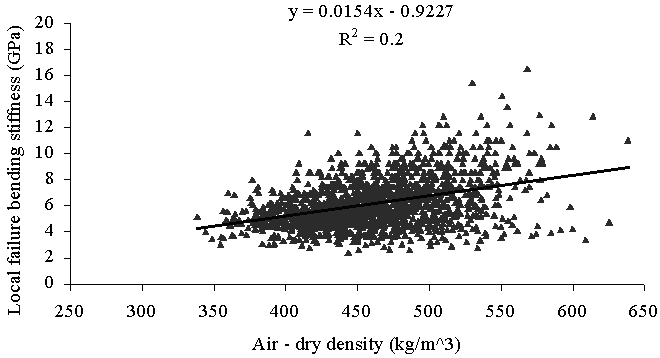
Mean air-dried density (kg/m3)
St.Dv.
Number of boards
Upper-top logs
442.79
38.69
218
Top logs
440.1
41.04
295
Middle logs
441.8
42.29
339
Butt logs
462.5
46.58
333
Tab. 1: Variations of average air-dried density of corewood according to log types in 62 radiata pine trees (test
data obtained from boards located in P1 & P2 , see Appendix, Fig. A and Fig. B).
Stiffness and Tensile Strength In Radiata Pine Structural Boards
Degradation of structural boards due to knots is a major problem in timber processing. Generally there
was a lower local longitudinal stiffness around a knot (Xu 2002), and nearly 99% of tensile tested
boards failed at a knot zone (Xu et al. 2002).
The effect of knots weakening the stiffness and strength can only be attributed to the structure of the
knot-contained zone rather than the wood mass around the knots. The extracted knotwood was denser
than clearwood in radiata pine (Kininmonth 1961). However, along the longitudinal direction of a
structural board, the local stiffness in the surrounding of knots was much lower than that in clearwood
(Xu 2002). Figures 3 and 4 give the relationship between wood density, local failure stiffness and
tensile strength. As with the observation of Walford (1981), the wood density around the weakest point
of a structural board does not indicate the mechanical properties there.
Fig. 3: The correlation between the air-dry density and the local failure stiffness EP, fail (data from 1589 boards,
and smal clearwood samples for density testing were cut from an adjacent zone to the failure point in each
board).
4th plant Biomechanics International Conference – East Lansing, USA
Page 4
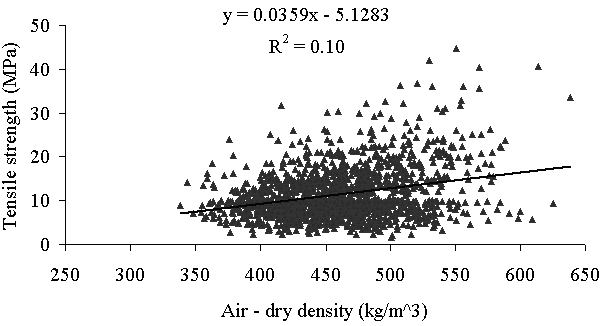
Fig. 4: The correlation between the air-dry density and the tensile strength (data from1589 boards, and smal
clearwood samples for density testing were cut from an adjacent zone to the failure point in each board).
The influence of structural factors associated with knots on the mechanical properties of structural
timber has been a focus of wood scientists since the 1970s. Structural failure associated with knots has
been interpreted previously by three hypotheses: i.e stress concentrations, knot area ratio (KAR), and
local grain deviation. The stress concentration theory has been generally employed to describe the
propagation of failure due to an internal or surface check that may result from drying in the knotty
zone (Gordon 1978, Bodig & Jayne 1982, Cramer & Goodman 1983, Tang 1984). The stress
concentration theory assumes that: “
In a homogenous specimen uniformly loaded in tension, the path
by which stress is transmitted from one end of the specimen to the other can be represented by stress
trajectories. In this case the load is borne uniformly throughout the specimen and all parts are equally
stressed. However if the specimen contains a crack, or notch, or in the case of timber a knot, the stress
trajectories have to find ways round and they tend to crowd the edge of the defect where the local
stress can be much higher than the average value. The sharper the crack the greater the stress
concentration. Although a round hole is a very blunt crack the stress concentration factor is 3 (at least
in the case of metals)” (Walker 1993). However, there is no experimental validation in previous
literatures to show that the crack propagation actually commences from a drying check. The second
hypothesis i.e. KAR theory treats a knot as a hole in the board, and the weakening of mechanical
properties is from the reduction of the cross section area of board (Green & Zerna 1968, Walker 1993).
In order to determine the KAR, the standards (AS 2858: 1986, NZS 3631: 1988) classified the knots as
face, margin, edge and arris knots according to the knot location within the board and indicated the
calculation methods of KAR. Based on the KAR theory, the maximum KAR in the board has been a
major parameter used to judge the grade of structural timber in visual grading systems (AS 2858: 1986,
BS 4978: 1988, NZS 3603: 1993). “
However, a single parameter, i.e., KAR alone, does not reliably
indicate tensile strength, since there was no strong correlation between tensile strength and the
maximum KAR (R2 = 0.21), or tensile strength and the KAR at the actual failure point of the board (R2
= 0.19)” (Xu et. al. 2002). The third hypothesis, i.e grain deviation theory, considers the wood grain
pattern associated with knots as fluid flows around an island, called the flow grain analogy (Goodman
& Bodig 1980, Dabholkar 1980, Phillips et al. 1981). On the basis of the flow grain analogy, two-
dimensional finite element analysis has been used to predict the stress associated with grain deviation
4th plant Biomechanics International Conference – East Lansing, USA
Page 5
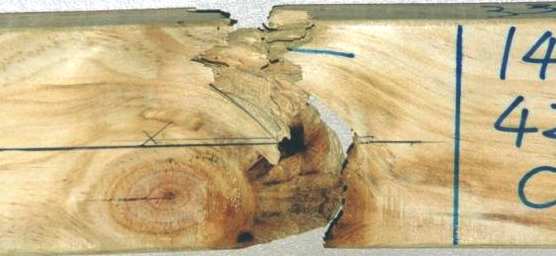

around knots (Phillips et al. 1981, Cramer & Goodman 1983, 1986, Zandbergs & Smith 1988,
Pellicane & Franco 1994). Naturally, this is a spatial problem, and inputting highly variable grain
geometry into the finite element software requires far more computing power than that the researchers
had. These researches therefore were rather superficial, and the validation has never been properly
done due to the tricky grain slope variation in knotty region.
Currently, a theoretical model (Xu 2002) is being developed to evaluate the effective local longitudinal
stiffness in a “mixed wood” (a combination of knotwood and stem wood) in terms of elastic moduli of
all components, volume fractions of all phases and growth angle of knots (angle between branch and
stem axes), which explains the reduction of stiffness in the knot-contained zones. In addition, 92% of
the knot failure in tension was categorized as two patterns: either boundary-failure or plane-failure (Xu
2001). In boundary failure, the failure surface goes along the interface between knot and stem wood
(Fig. 5, 6, 7). In plane-failure, the failure crosses the symmetrical plane of knot and the failure surface
contains the pith of the branch (Fig. 8, 9, 10).
Fig. 5: The boundary-failure in a margin knot.
Fig. 6: The boundary-failure in an edge knot.
4th plant Biomechanics International Conference – East Lansing, USA
Page 6
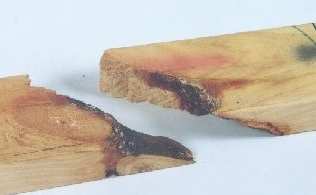
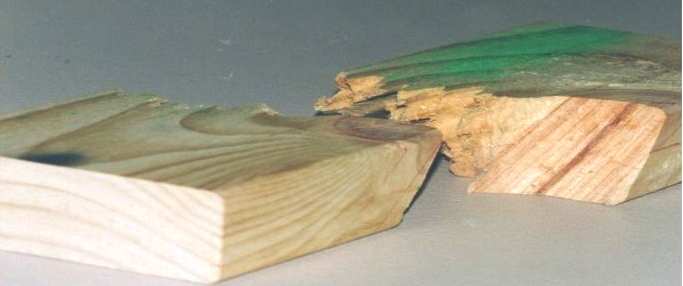
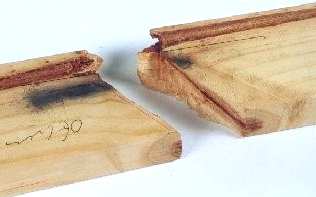
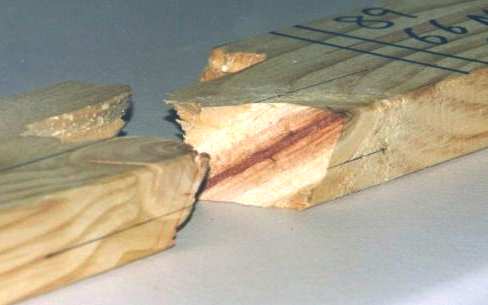
Fig. 7: The boundary-failure in a through arris knot.
Fig. 8: The plane-failure in a margin knot.
Fig. 9: The plane-failure in an edge knot.
Fig. 10: The plane-failure in a through arris knot.
4th plant Biomechanics International Conference – East Lansing, USA
Page 7
An encased knot is almost completely separated from the adjacent stem wood because of the bark of
the knot (Fig. 5, 6, 7). In this case, the tensile failure propagates along the boundary of the encased
knots to form a boundary-failure pattern. An intergrown knot from a living branch may produce both
boundary-failure and plane-failure. When the boundary of an intergrown knot is totally inside a surface
of the board and there are not severe interior or surface checks in the knot, the failure is prone to
follow a boundary-failure pattern. In other cases, an intergrown knot in tension may display a plane-
failure pattern. Brittle pith is the weakest site on the symmetrical plane of a knot. An initial failure
occurs where the symmetrical plane of a knot coincides with the plane of drying stress concentration
(Kininmonth 1961, Liu 1998). Therefore, brittle pith, drying damage and stress concentration on the
symmetric plane of a knot may be the causes of plane-failure.
Further structural mechanical analysis is expected to quantitatively clarify where a structural board
may break and which pattern of a failure may follow. This knowledge will greatly benefit the
improvement of timber visual stress-grading system, thus forest industry.
Stiffness and Strength in Individual Wood Cel s
Wood cell wall consists of cellulose microfibrils embedded in a lignin-hemicelluloses matrix with the
microfibrils coiled in a helix-like path within the cell wall (Yamamoto & Kojima 2002). The influence
of cell structure on cell mechanical properties has been a multidisciplinary research (Treloar 1960,
Hearle 1963, Mark 1967, Jaswon et al. 1968, Cave 1968, 1969, Schniewind 1972, Bodig & Goodman
1973, Preston 1974, Bodig and Jayne 1982, Yamamoto & Kojima 2002). It has been reported by many
authors that an increase in microfibril angle generally leads to a lower wood stiffness (Cave & Walker
1994, Walker & Butterfield 1995, Cave 1997a, 1997b, Tsehaye et. al. 1998, Navi 1998, Evans & Ilic
2001).
HOWEVER, THE STUDY OF STRUCTURAL MECHANICS AT THE LEVEL IN
RELATION TO WOOD CELLS IS STILL IN ITS INFANCY as addressed below.
First of all, the significance regarding the influence of cell ultrastructure on wood strength has not been
emphasized. Secondly, there are some gaps in the study of cell structure-stiffness. The study of cell
structure-stiffness includes understanding and quantifying the contributions of various structural
factors, such as microfibrils, cellular matrix, microfibrils orientation, and the volume fractions of all
phase, to cell stiffness. However, among all cell structural factors, only the mean microfibril angle has
been emphasized in recent years. The predictive model of mean cell stiffness in terms of mean
microfibril angle (Cave 1968, 1969) has been frequently used in recent years. However, the predicted
cell wall stiffness arising from Cave’s microfibril elasticity model showed a considerable disparity
with his experimental results at lower microfibril angles (Fig. 11). Finally, there are some limitations
of techniques for determining the spatial arrangement of microfibrils and the influence of the helix of
microfibrils on cell stiffness and cell strength. All these certainly hampered the progress of wood cell
structural mechanics.
4th plant Biomechanics International Conference – East Lansing, USA
Page 8
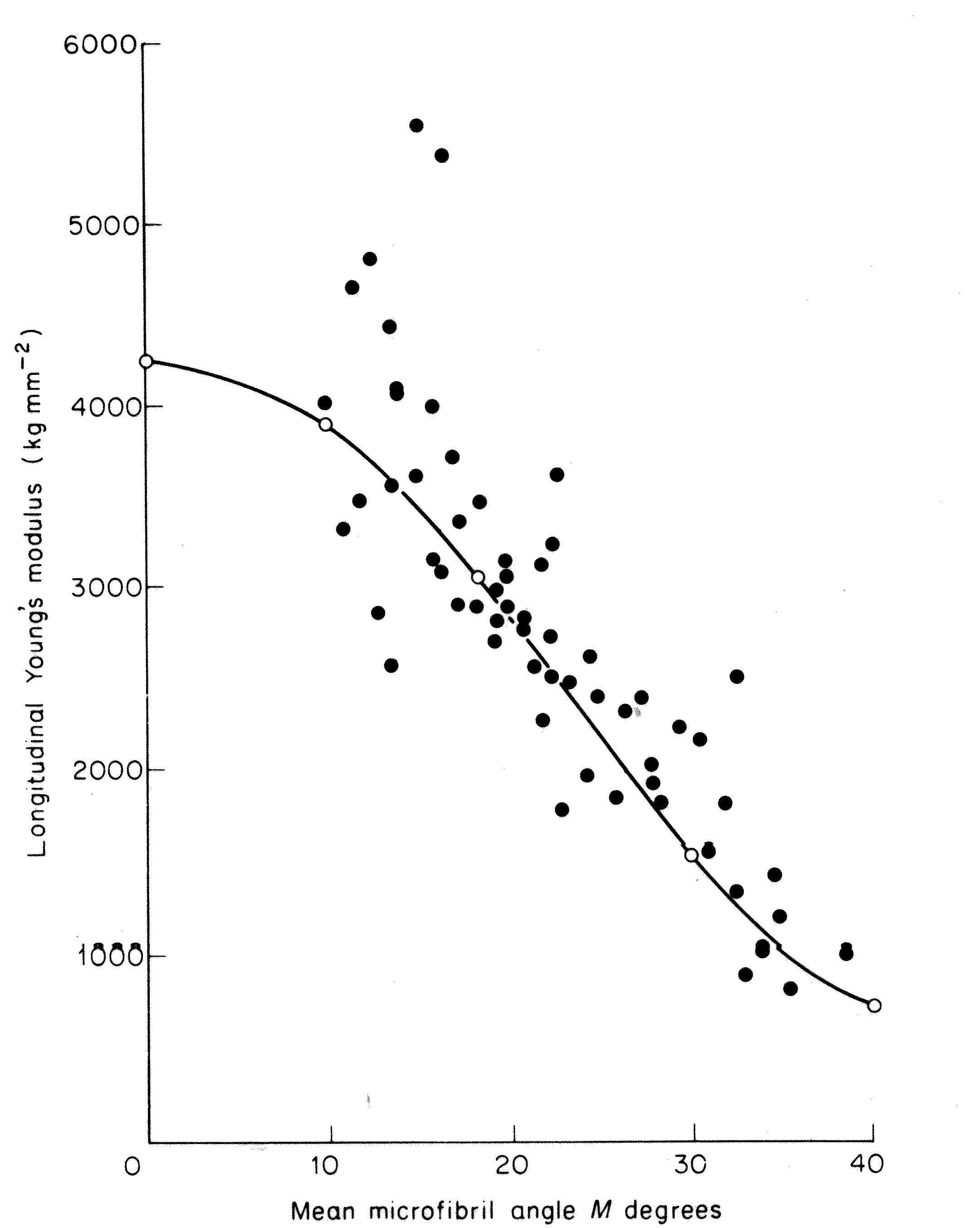
Fig. 11: The predictions and measurements of cel wal stiffness vs. mean microfibril angle (after Cave, 1968).
Note: —o—represents the theoretical curve; • represents the experimental data.
Summary
Three topics require immediate attention in wood structural mechanics: the cause of the worst juvenile
wood in trees, the weakening of timber mechanical properties due to knots, and the influences of cell
morphology on cell stiffness and cell strength.
The butt log is valuable because of its larger size, higher density, and relatively stronger and stiffer
outerwood. However, the poorest characteristic mechanical properties in the corewood and an
enlarged low-stiffness wood zone may offset the advantages of the outerwood in the butt logs. The
problems will be more serious with the rapid increase of juvenile wood proportion due to the reduction
of rotation age of radiata pine. A thorough structural mechanics study on the cause of the low-grade
structural material will be useful for the genetic selection, modification and breeding program to
improve radiata pine wood properties.
Knots significantly weaken the mechanical properties in structural timber. Current research has
demonstrated the local stiffness around a knot in terms of growth angle of branch and the volume
fraction of knots, which partially explains why the stiffness in denser knotty zones is far lower than
that in adjacent clearwood. The quantitative influence of grain deviation on stiffness requires further
investigation to formulate a complete theory. KAR alone is poorly correlated to the tensile strength,
which reveals that KAR is not the dominant structural factor for the weakening of timber strength
around knots. Further investigation involving additional structural factors requires an extensive
structural mechanics study, which is useful for improving the timber visual grading system and helpful
to code writers.
4th plant Biomechanics International Conference – East Lansing, USA
Page 9
The wood cells are basic elements of wood-based biomaterials. Determining key ultrastructural factors
affecting the cell properties is fundamental for genetic engineering and will create a solid knowledge
base to underpin the breeding program and potential genetic modification, and will thereby benefit
forest industry.
Acknowledgements
The support of AGMARDT (Agricultural & Marketing Research & Development Trust) Fund is
gratefully acknowledged.
References
AS 2858: 1986 (1986). Australian standard for timber-softwood-visually stress- graded for structural
purposes, Standards Association of Australia. North Sydney, Australia.
Barrett JD, Kellogg RM (1991). Bending strength and stiffness of second growth Douglas- fir
dimension lumber, Forest Prod. J., 41 (10): 35-43.
Bodig J, Goodman JR (1973). Prediction of elastic parameters for wood, Wood Science, 5(4): 249-
264.
Bodig J, Jayne BA (1982). Mechanics of wood and wood composite, Van Nostrand Reinhold, New
York. 712pp.
BS 4978: 1988 (1988). British standard specification for softwood grades for structural use, British
Standards Institution, UK.
Cave ID (1968). The anisotropic elasticity in the plant cell wall, Wood Sci. and Tech. 2: 268-278.
Cave ID (1969). The longitudinal elastic modulus of pinus radiata, Wood Sci.and Tech. 3: 40-48.
Cave ID (1997a). Theory of x-ray measurement of microfibril angle, Part 1: The condition for
reflection, Wood Sci. Technol. 31:143-152.
Cave ID (1997b). Theory of x-ray measurement of microfibril angle, Part 2: The diffraction pattern,
Wood Sci. Technol. 31:225-234.
Cave ID, Walker JCF (1994). Stiffness of wood in fast-grown plantation softwoods: the influence of
microfibril angle, Forest Products Journal 44(5):43-48.
Courchene T, Lam F, Barrett JD (1998). The effect of edge knots on the strength of SPF MSR lumber,
For. Prod. J. 48(4): 75-81.
Cown DJ (1992). Corewood (juvenile wood) in
Pinus Radiata - Should we be concerned? NZ Journal
of Forestry Science 22(1): 87-95. 1992.
Cown DJ, McConchie DL, Young GD (1991). Radiata pine wood properties survey, FRI Bulletin No.
50(Revised edition), Forest Research Institute, NZ.
Cramer SM, Goodman JR (1983). Model for stress analysis and strength prediction of lumber, Wood
and Fibre Sci. 15(3):338-349.
Cramer SM, Goodman JR (1986). Failure modelling: a basis for strength prediction of lumber, Wood
Fiber Sci. 18(3): 446-459.
Dabholkar AY (1980). Analysis of wood with knots and cross grain, PhD thesis, Department of Civil
Engineering, Colorado State University, Ft. Collins, CO.
4th plant Biomechanics International Conference – East Lansing, USA
Page 10
Donaldson LA (1992). Within- and between-tree variation in microfibril angle in
Pinus Radiata, NZ
Journal of Forestry Science 22: 77-86.
Evans R, Ilic J (2001). Rapid prediction of wood stiffness from microfibril angle and density, For.
Prod. J. 51(3): 53-57.
Goodman JR, Bodig J (1980). Tension behavior of wood - an anisotropic, inhomogeneous material,
Final Report to the National Science Foundation, Colorado State University, Fort Collins, CO.
Grant DJ, Anton A Lind P (1984). Bending strength, stiffness, and stress-grade of structural pinus
radiata: effect of knots and timber density, New Zealand Journal of Forestry Sci., 14(3): 331-48.
Green AE, Zerna W (1968). Theoretical elasticity, 2nd ed. Oxford University Press, 368 pp.
Gordon JE (1978). Structures, or why things don’t fall down, Plenum Press, London.
Hearle JWS (1963). The fine structure of fibres and crystalline polymers, Part III: Interpretation of the
mechanical properties of fibres, Journal of Applied Polymer Science, 7: 1207-1223.
Jaswon MA, Gillis PP, Mark RE (1968). The elastic constants of crystalline native cellulose, Proc.
Roy. Soc. A 306:389-412.
Kininmonth JA (1961). Checking of intergrown knots during seasoning of radiata pine sawn timber,
Technical Paper No. 30, New Zealand Forest Service.
Kunesh RH, Johnson JW (1972). Effect of single knots on tensile strength of 2- by 8- inch Douglas-fir
dimensional lumber, Fore. Prod. J., 22(1): 32-37.
Liu H (1998). A developed model for the simulation of drying deformation in radiata pine boards,
PhD thesis, Lincoln University, New Zealand.
Mark RE (1967). Cell wall mechanics of tracheids, Yele University Press, New Haven and London.
Madsen B (1992). Structural Behaviour of Timber, Timber Engineering Ltd., North Vancouver, British
Columbia, Canada.
Navi P (1998). The influence of microfibril angle on wood cell and wood mechanical properties,
experimental and numerical study, In: Butterfield, B.G. (ed.), Microfibril Angle in Wood,
IAWA/IUFRO.
Nguedjio CF (1999). Effect of knots on the relation between flatwise and edgewise stiffness,
Proceedings of PACIFIC Timber Engineering Conference, Rotorua, New Zealand.
NZS 3603: 1993 (1993). New Zealand timber structures standard, Standards Association of New
Zealand, Wellington, New Zealand.
NZS 3631: 1988 (1988). New Zealand timber grading rules, Standards Association of New Zealand,
Wellington, New Zealand.
Pellicane PJ, Franco N (1994). Modelling wood pole failure, Part2: Material and geometric
considerations, Wood Sci. and Tech., 28(4): 261-274.
Pellicane PJ, Stanfill-McMillan K, Tichy RJ (1987). Effects of knots near the fingers of finger-jointed
dimension lumber, Forest Prod. J., 37(5): 13-16.
Perstorper M (1996). Lengthwise variation in grading parameters and comparison with bending
strength tests, Proceedings10th International Symposium on Nondestructive Testing of Wood
(edit J.L. Sandoz), Lausanne, Presses Polytechniques et Universitaires Romandes, Lausanne,
pp.341-50.
4th plant Biomechanics International Conference – East Lansing, USA
Page 11
Phillips GE, Bodig J, Goodman JR (1981). Flow-grain analogy, Wood Sci., 14(2): 55-64.
Preston RD (1974). The physical biology of plant walls, Chapman & Hall, London.
Tang RC (1984). Stress concentration around knots in laminated beams, Wood Fiber Sci. 16(1): 57-71.
Schniewind AP (1972). Elastic behavior of the wood fiber, Chapter 4 in theory and design of wood and
fiber composite materials, Editor: Benjamin A. Jayne, Syracuse University Press, New York.
Tsehaye Addis, Buchanan AH., Meder R., Newman RH., Walker JCF (1998). Microfibril angle:
determining wood stiffness in radiata pine, In: Butterfield, B.G. (ed.), Microfibril angle in wood
.
IAWA/IUFRO.
Tustin J, Wilcox M (1978). The relative importance of branch size and wood density to the quality of
Douglas-fir framing lumber: A review of Douglas–fir in New Zealand, FRI symposium No. 15,
Rotorua, New Zealand.
Walker JCF (1998a). Corewood: docking the dog's tail, Part 1: An alternative road map, N.Z.
Forestry 42 (4) 5-6.
Walker JCF (1998b). Corewood: docking the dog's tail, Part 2: The need toparticularise,
N.Z.Forestry 42(5): 4-6.
Walker JCF (1993). Primary wood processing: principles and practice, Chapman & Hall, London.
595pp.
Walker JCF, Butterfield BG (1995). The importance of microfibril angle for the processing industries,
N.Z. Forestry 40(4): 34-40.
Walford GB (1981). Combined visual and mechanical grading of
Pinus Radiata, New Zealand Journal
of Forestry Science 11(3): 298-303.
Xu P, Walker JCF (in press). Stiffness gradients in radiata pine trees, Wood Sci. Technol.
Xu P, Buchanan AH, Walford GB, Walker JCF (2002). Estimating tensile strength in pinus radiata
structural timber, New Zealand Journal of Forestry Science 32(1):70-85.
Xu P (2002). Estimating the influence of knots on the local longitudinal stiffness in radiata pine
structural timber, Wood Sci. Technol. 36(6): 501-509.
Xu P (2001). The mechanical properties and stability of radiata pine structural timber, Ph.D thesis,
University of Canterbury, New Zealand.
Xu P (2003). Gradients of mechanical properties in radiata pine trees, Proc.5th IUFRO International
Conference, 2003, Rotorua, New Zealand, in press.
Yamamoto H, Kojima Y (2002). Properties of cell wall constituents in relation to longitudinal
elasticity of wood, Part I: Formulation of the longitudinal elasticity of an isolated wood fiber,
Wood Sci. Technol. 36: 55-74.
Zandbergs JG, Smith FW (1988). Finite element fracture prediction for wood with knots and cross
grain, Wood & Fiber Sci. 20(1): 97-106.
4th plant Biomechanics International Conference – East Lansing, USA
Page 12













Appendix
m
Upper-top log
4.2
m
4.2
Top log
ood
orew
m
C
4.2
Middle log
m
4.2
Butt log
Fig. A: Cutting pattern of stems.
Fig. B: Sawing patterns of logs.
4th plant Biomechanics International Conference – East Lansing, USA
Page 13
























